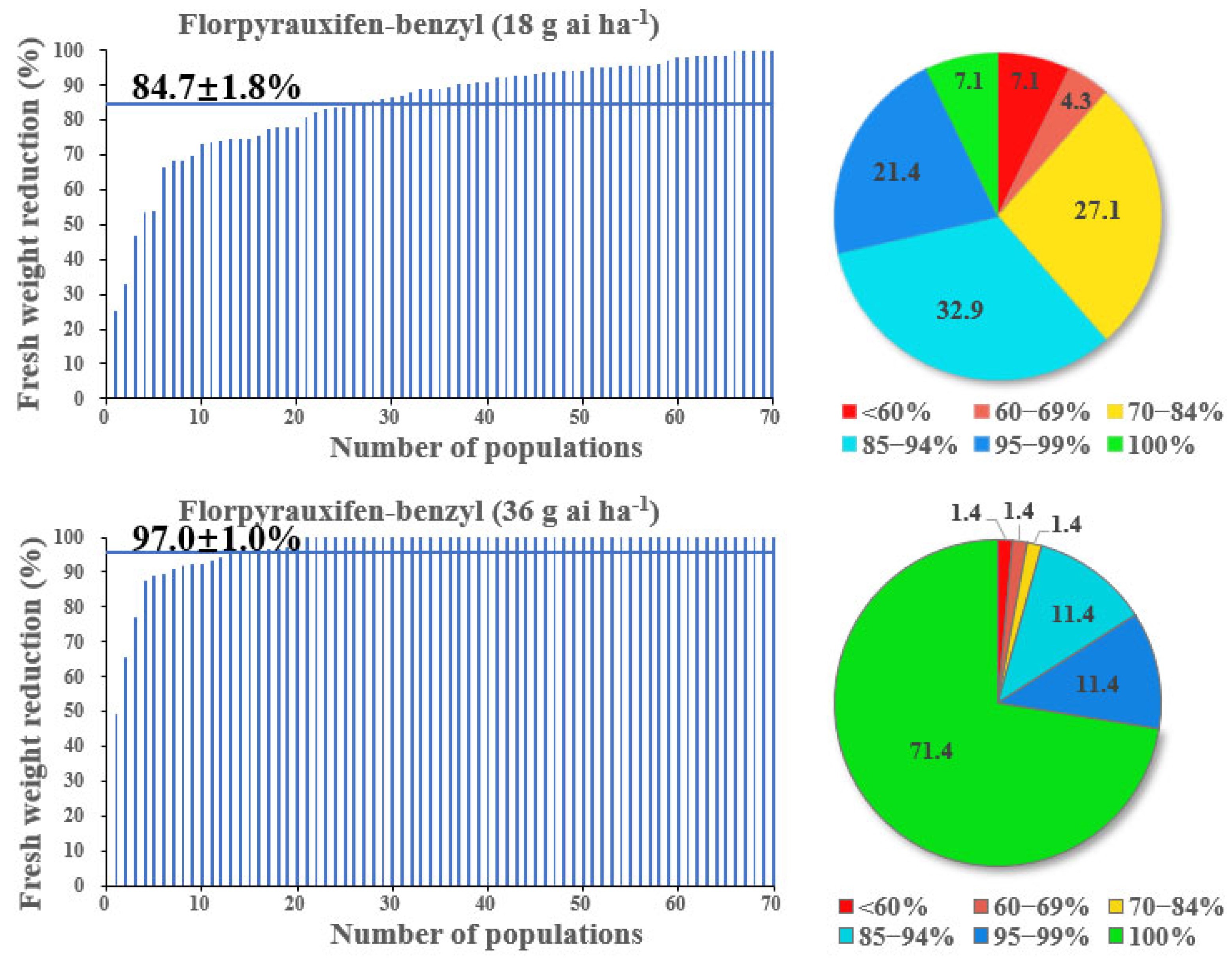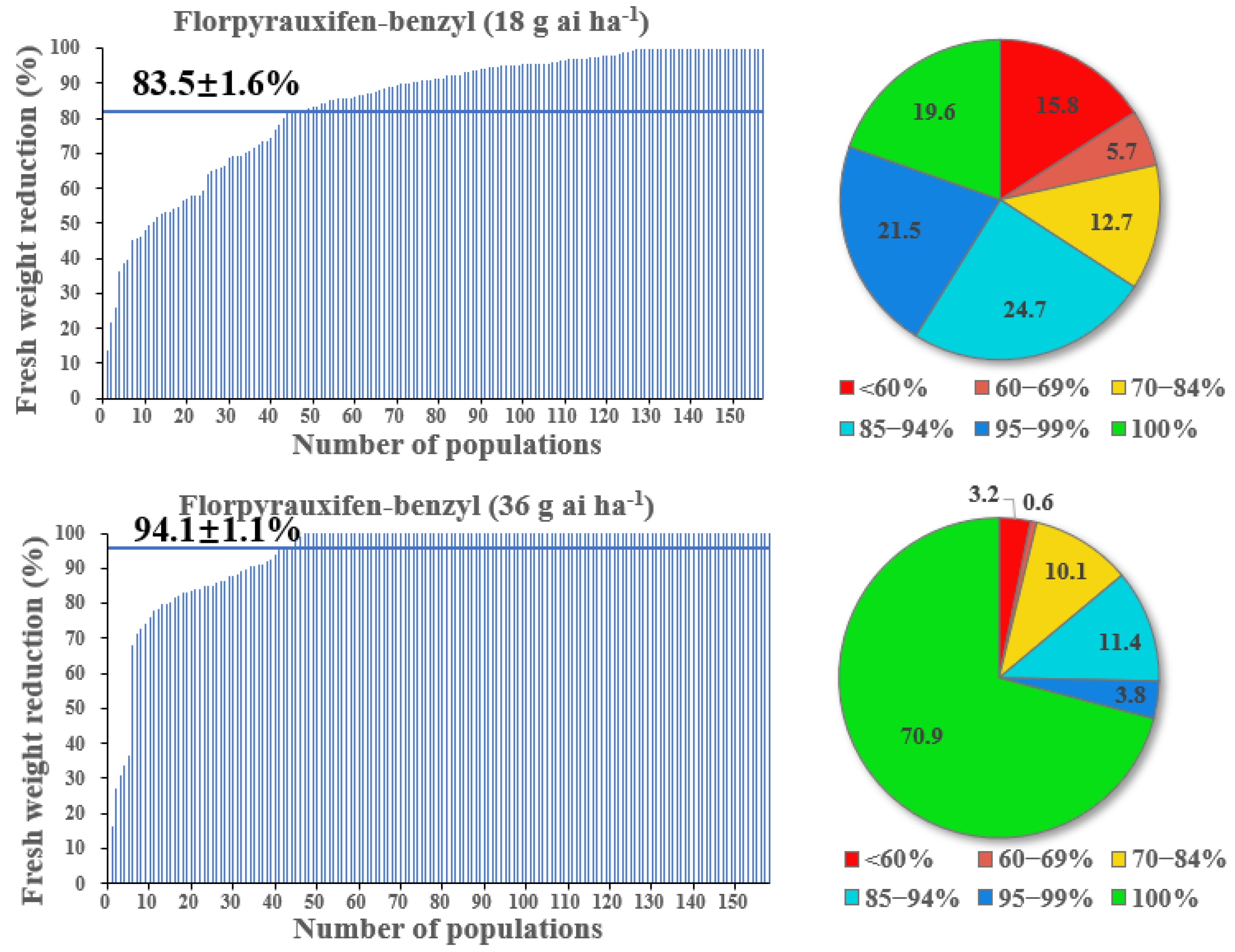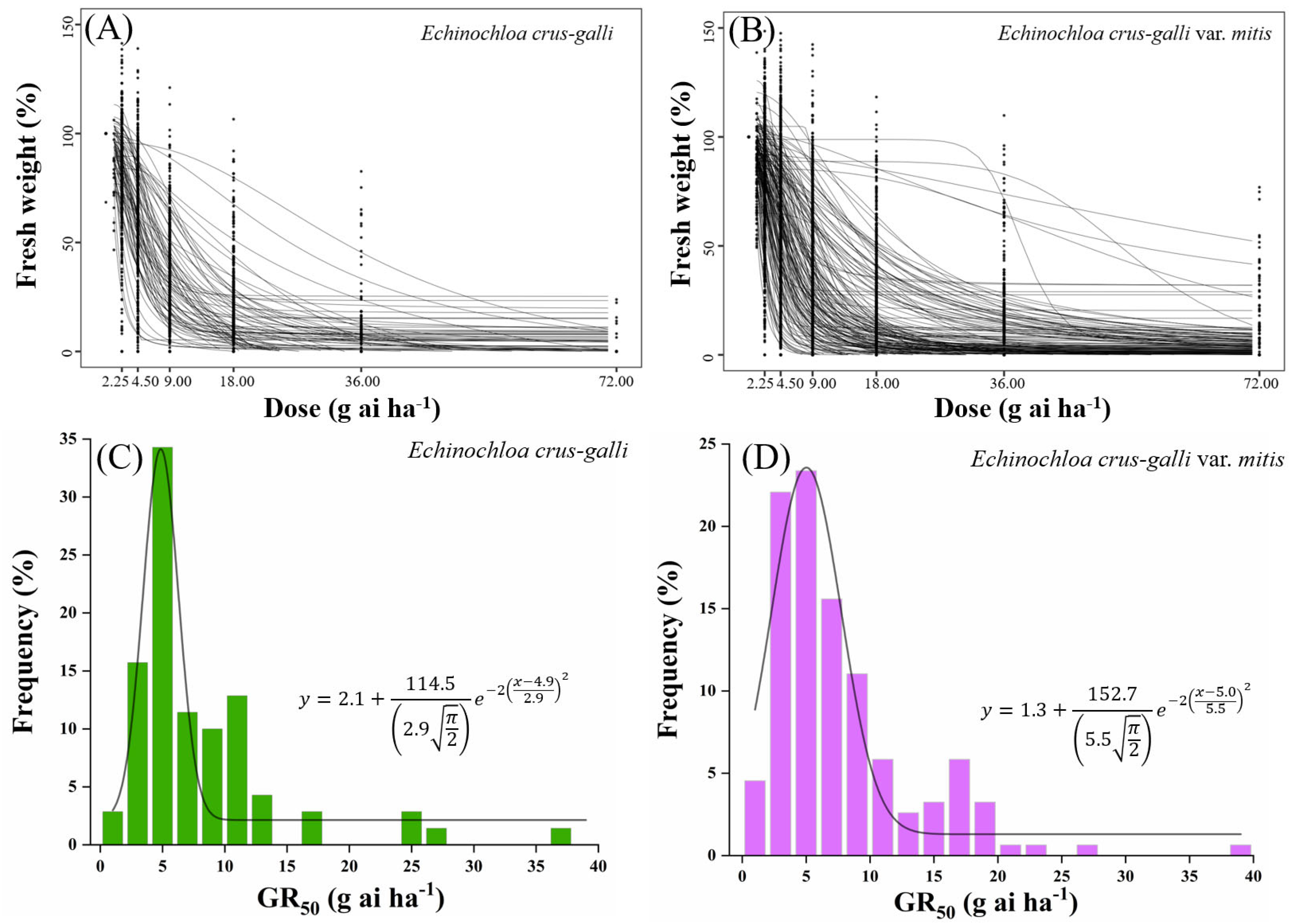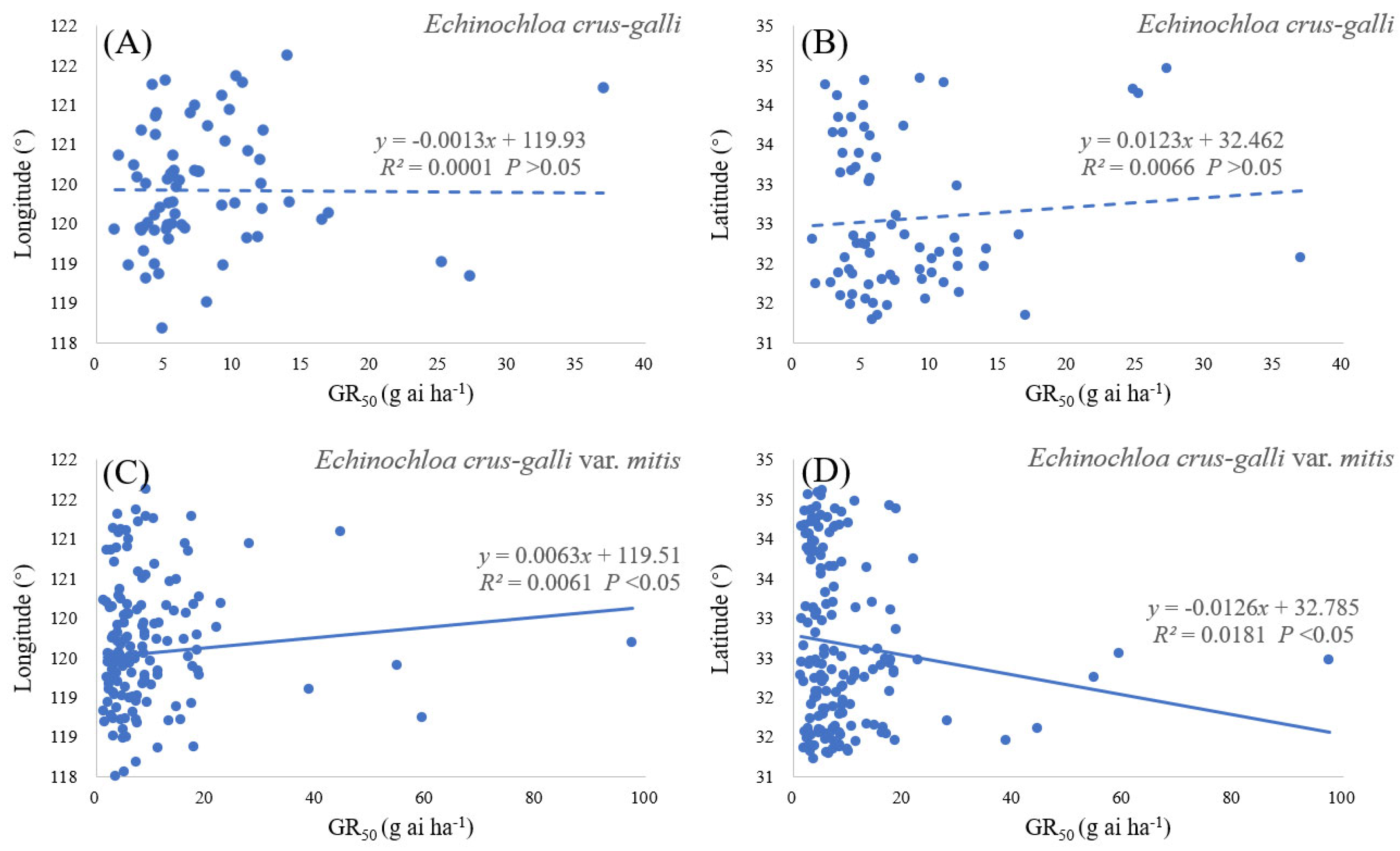Assessment of Florpyrauxifen-Benzyl Sensitivity in Echinochloa crus-galli and E. crus-galli var. mitis: A Case Study with 228 Populations in Eastern China
Abstract
1. Introduction
2. Materials and Methods
2.1. Collection of Plant Materials
2.2. Whole-Plant Dose–Response Bioassay
2.3. Data Analysis
3. Results
3.1. Sensitivity to Label or Half Label Dose of Florpyrauxifen-Benzyl
3.2. Florpyrauxifen-Benzyl Resistance
3.3. Inter- and Intra-Specific Differences in Florpyrauxifen-Benzyl Resistance
4. Discussion
5. Conclusions
Supplementary Materials
Author Contributions
Funding
Data Availability Statement
Acknowledgments
Conflicts of Interest
References
- Chung, I.M.; Ahn, J.K.; Yun, S.J. Assessment of allelopathic potential of barnyard grass (Echinochloa crus-galli) on rice (Oryza sativa L.) cultivars. Crop Prot. 2001, 20, 921–928. [Google Scholar] [CrossRef]
- Kraehmer, H.; Jabran, K.; Mennan, H.; Chauhan, B.S. Global distribution of rice weeds—A review. Crop Prot. 2016, 80, 73–86. [Google Scholar] [CrossRef]
- Zhang, Z.; Gu, T.; Zhao, B.; Yang, X.; Peng, Q.; Li, Y.; Bai, L. Effects of common Echinochloa varieties on grain yield and grain quality of rice. Field Crops Res. 2017, 203, 163–172. [Google Scholar] [CrossRef]
- Chen, G.; Tang, W.; Li, J.; Lu, Y.; Dong, L. Distribution characteristics of Echinocloa species in rice fields in China: A case survey on 73 sites from nine provincial administrative regions. Chin. J. Rice Sci. 2019, 33, 368–376. [Google Scholar]
- Li, Y.H. Weed Flora of China; China Agriculture Press: Beijing, China, 1998; pp. 1214–1221. [Google Scholar]
- Chen, Y.; Masoom, A.; Huang, Z.; Xue, J.; Chen, G. Interspecific and intraspecific differences in seed germination response to different temperatures of three Echinochloa rice weeds: A case study with 327 populations. Weed Sci. 2025, 73, e23. [Google Scholar] [CrossRef]
- Chen, G.; Zhuang, X.; Masoom, A.; Chen, Y.; Gu, Y.; Zhang, J. Echinochloa crus-galli seedlings surviving florpyrauxifen-benzyl applications have a greater potential to produce resistant seeds. Weed Technol. 2023, 38, e12. [Google Scholar] [CrossRef]
- Chen, G.Q.; Wang, Q.; Yao, Z.W.; Zhu, L.F.; Dong, L.Y. Penoxsulam-resistant barnyardgrass (Echinochloa crus-galli) in rice fields in China. Weed Biol. Manag. 2016, 16, 16–23. [Google Scholar] [CrossRef]
- Miller, M.R.; Norsworthy, J.K. Florpyrauxifen-benzyl weed control spectrum and tank-mix compatibility with other commonly applied herbicides in rice. Weed Technol. 2018, 32, 319–325. [Google Scholar] [CrossRef]
- Hwang, J.-I.; Norsworthy, J.K.; Gonzalez-Torralva, F.; Piveta, L.B.; Priess, G.L.; Barber, L.T.; Butts, T.R. Absorption, translocation, and metabolism of florpyrauxifen-benzyl and cyhalofop-butyl in cyhalofop-butyl-resistant barnyardgrass Echinochloa crus-galli (L.) P. Beauv. Pestic. Biochem. Physiol. 2022, 180, 104999. [Google Scholar] [CrossRef]
- Hu, W.; Li, Y.; Wang, Y.; Li, Q.; Wang, Z.; Zhao, X.; Fan, F.; Zhao, N.; Liao, M. ACCase and ALS susceptibility status of Echinochloa spp. populations in Anhui Province, China, and their baseline sensitivity to the HPPD inhibitor tembotrione. Chil. J. Agric. Res. 2025, 85, 445–458. [Google Scholar] [CrossRef]
- Brassard, D.; Whitford, F.; Pike, D.; Burroughs, F.; Hanger, G.; Johnson, W. The Pesticide Marketplace; Purdue University Extension, PPP-71; Purdue University: West Lafayette, IN, USA, 2006. [Google Scholar]
- Jin, M.; Chen, L.; Deng, X.W.; Tang, X. Development of herbicide resistance genes and their application in rice. Crop J. 2022, 10, 26–35. [Google Scholar] [CrossRef]
- Mesnage, R.; Székács, A.; Zaller, J.G. Herbicides: Brief history, agricultural use, and potential alternatives for weed control. In Herbicides; Elsevier: Amsterdam, The Netherlands, 2021. [Google Scholar]
- Masoom, A.; An, K.; Chen, Y.; Dai, Q.; Chen, G. Inter- and intra-specific differences in seed germination responding to varying osmotic potentials in 261 Echinochloa populations collected from rice fields in eastern China. Agronomy 2025, 15, 1169. [Google Scholar] [CrossRef]
- Chen, G.; Chen, Y.; Masoom, A.; Wu, J.; Wei, H. Baseline sensitivity of Echinochloa glabrescens to florpyrauxifen-benzyl on a regional scale: A case study of Jiangsu Province, China. Weed Technol. 2025, 39, e35. [Google Scholar] [CrossRef]
- Chen, G.; An, K.; Chen, Y.; Lu, C.; Liu, Y. Double-spraying with different routes significantly improved the performance of both pre- and post-emergence wheat herbicides applied by unmanned aerial spraying systems. Crop Prot. 2024, 176, 106503. [Google Scholar] [CrossRef]
- Barroso, J.; Loureiro, I.; Escorial, M.C.; Chueca, M.C. The response of Bromus diandrus and Lolium rigidum to dalapon and glyphosate I: Baseline sensitivity. Weed Res. 2010, 50, 312–319. [Google Scholar] [CrossRef]
- Paterson, E.A.; Shenton, Z.L.; Straszewski, A.E. Establishment of the baseline sensitivity and monitoring response of Papaver rhoeas populations to florasulam. Pest Manag. Sci. 2002, 58, 964–966. [Google Scholar] [CrossRef]
- Lim, S.; Kim, H.; Noh, T.; Lim, J.; Yook, M.; Kim, J.; Yi, J.; Kim, D. Baseline sensitivity of Echinochloa crus-galli and E. oryzicola to florpyrauxifen-benzyl, a new synthetic auxin herbicide, in Korea. Front. Plant Sci. 2021, 12, 656642. [Google Scholar] [CrossRef]
- Li, Z.; Sun, X.; Yu, S.; Sun, H.; Lian, L.; Peng, X.; Jin, T.; Liu, W.; Wang, H. Baseline sensitivity of Echinochloa crus-galli (L.) P. Beauv. and Leptochloa chinensis (L.) Nees to flusulfinam, a new 4-hydroxyphenylpyruvate dioxygenase (HPPD)-inhibiting herbicide in rice, in China. Plants 2025, 14, 1425. [Google Scholar] [CrossRef]
- Deng, W.; Yin, H.; Ge, Z.; Yao, S.; Wu, J.; Zhu, A.; Yang, Q.; Yuan, S. Distribution, frequency and molecular basis of penoxsulam, metamifop and florpyrauxifen-benzyl resistance in Echinocloa spp. from rice fields across Jiangsu Province, China. Pestic. Biochem. Physiol. 2025, 207, 106218. [Google Scholar] [CrossRef] [PubMed]
- Total Sown Area of Farm Crops and Output (2024). Available online: https://tj.jiangsu.gov.cn/2024/nj10/nj1009.htm (accessed on 4 September 2024).
- Chen, G.; An, K.; Xue, J.; Deng, W.; Huang, Z.; Xu, Y. Widespread occurrence of cyhalofop-resistant Leptochloa chinensis in eastern China was mainly propelled by target-site mutations. Pest Manag. Sci. 2025, 81, 5589–5601. [Google Scholar] [CrossRef] [PubMed]
- Seefeldt, S.S.; Jensen, J.E.; Fuerst, E.P. Log-logistic analysis of herbicide dose-response relationships. Weed Technol. 1995, 9, 218–227. [Google Scholar] [CrossRef]
- Ritz, C.; Streibig, J.C. Bioassay analysis using R. J. Stat. Softw. 2005, 12, 1–22. [Google Scholar] [CrossRef]
- Chen, G.; An, K.; Chen, Y.; Zhuang, X. Double-spraying with different routes significantly improved control efficacies of herbicides applied by unmanned aerial spraying system: A case study with rice herbicides. Crop Prot. 2023, 167, 106203. [Google Scholar] [CrossRef]
- Beckie, H.J.; Tardif, F.J. Herbicide cross resistance in weeds. Crop Prot. 2012, 35, 15–28. [Google Scholar] [CrossRef]
- Moss, S.R. Baseline sensitivity to herbicides: A guideline to methodologies. In Proceedings of the Brighton Crop Protection Conference—Weeds, Brighton, UK, 12–15 November 2001; British Crop Protection Council: Farnham, UK, 2001; pp. 769–774. [Google Scholar]
- Wang, H.; Fang, J.; Li, X.; Sun, P.; Gao, H.; Ren, Y.; Liu, Y.; Feng, Z.; Dong, L. Epigenetic regulation of CYP72A385-mediated metabolic resistance to novel auxin herbicide florpyrauxifen-benzyl in Echinochloa crus-galli (L.) P. Beauv. J. Agric. Food Chem. 2024, 72, 9199–9214. [Google Scholar] [CrossRef]
- Takano, H.K.; Greenwalt, S.; Ouse, D.; Zielinski, M.; Schmitzer, P. Metabolic cross-resistance to florpyrauxifen-benzyl in barnyardgrass (Echinochloa crus-galli) evolved before the commercialization of Rinskor™. Weed Sci. 2023, 71, 77–83. [Google Scholar] [CrossRef]
- Hu, X.; Xu, Y.; Li, C.; Mao, H.; Liu, Z.; Xiao, Y.; Li, Y.; Yang, X. A five-year examination into the occurrence of herbicide-resistant barnyardgrass populations in paddy from Jiangsu Province, China. Sci. Rep. 2025, 15, 14781. [Google Scholar] [CrossRef]
- Wang, H.; Li, X.; Ren, Y.; Gao, H.; Feng, Z.; Dong, L. Low expression of auxin receptor EcAFB4 confers resistance to florpyrauxifen-benzyl in Echinochloa crus-galli (L.) P. Beauv. Pestic. Biochem. Physiol. 2024, 204, 106099. [Google Scholar] [CrossRef]
- Yu, X.; Sun, J.; Yang, Y.; Zhang, J.; Lu, Y.; Tang, W. Enhanced herbicide metabolism and target site mutation enabled the multiple resistance to cyhalofop-butyl, florpyrauxifen-benzyl, and penoxsulam in Echinochloa crus-galli. J. Agric. Food Chem. 2024, 72, 11405–11414. [Google Scholar] [CrossRef]
- Ul Haq, M.Z.; Zhang, Z.; Wei, J.; Qiang, S. Ethylene biosynthesis inhibition combined with cyanide degradation confer resistance to quinclorac in Echinochloa crus-galli var. mitis. Int. J. Mol. Sci. 2020, 21, 1573. [Google Scholar] [CrossRef] [PubMed]
- Bonow, J.F.L.; Lamego, F.P.; Andres, A.; Avila, L.A.; TelÓ, G.M.; Egewarth, K. Resistance of Echinochloa crusgalli var. mitis to imazapyr+imazapic herbicide and alternative control in irrigated rice. Planta Daninha 2018, 36, e018168627. [Google Scholar]
- de Mol, F.; Gerowitt, B.; Kaczmarek, S.; Matysiak, K.; Sonderskov, M.; Mathiassen, S.K. Intraregional and inter-regional variability of herbicide sensitivity in common arable weed populations. Weed Res. 2015, 55, 370–379. [Google Scholar] [CrossRef]
- Jasieniuk, M.; BruleBabel, A.L.; Morrison, I.N. The evolution and genetics of herbicide resistance in weeds. Weed Sci. 1996, 44, 176–193. [Google Scholar] [CrossRef]
- Hawkins, N.J.; Bass, C.; Dixon, A.; Neve, P. The evolutionary origins of pesticide resistance. Biol. Rev. 2019, 94, 135–155. [Google Scholar] [CrossRef] [PubMed]
- Qu, X.; Zhang, Z.; Gao, P.; Chen, W.; Qiang, S. Intra- and cross-field dispersal of Beckmannia syzigachne seed by a combine harvester. Pest Manag. Sci. 2021, 77, 4109–4116. [Google Scholar] [CrossRef] [PubMed]
- Monteiro, A.; Santos, S. Sustainable approach to weed management: The role of precision weed management. Agronomy 2022, 12, 118. [Google Scholar] [CrossRef]
- Xuan, T.D.; Khanh, T.D.; Minh, T.T.N. Implementation of conventional and smart weed management strategies in sustainable agricultural production. Weed Biol. Manag. 2025, 25, e7000. [Google Scholar] [CrossRef]
- Yu, Q.; Powles, S. Metabolism-based herbicide resistance and cross-resistance in crop weeds: A threat to herbicide sustainability and global crop production. Plant Physiol. 2014, 166, 1106–1118. [Google Scholar] [CrossRef]
- Inci, D.; Al-Khatib, K. Assessment of florpyrauxifen-benzyl in water-seeded rice systems as affected by application timing. Crop Prot. 2024, 185, 106886. [Google Scholar] [CrossRef]
- Getahun, S.; Kefale, H.; Gelaye, Y. Application of precision agriculture technologies for sustainable crop production and environmental sustainability: A systematic review. Sci. World J. 2024, 2024, 2126734. [Google Scholar] [CrossRef] [PubMed]





| City | E. crus-galli | E. crus-galli var. mitis | ||
|---|---|---|---|---|
| Number of Populations | Average GR50 Value (g ai ha−1) | Number of Populations | Average GR50 Value (g ai ha−1) | |
| Changzhou | 6 | 5.7 | 15 | 7.7 ab |
| Huaian | 7 | 4.1 | 13 | 5.8 b |
| Lianyungang | 4 | 11.7 | 11 | 7.6 ab |
| Nanjing | / | / | 17 | 12.7 ab |
| Nantong | 10 | 11.0 | 12 | 7.4 ab |
| Suqian | 5 | 9.9 | 10 | 5.7 b |
| Suzhou | 7 | 7.1 | 11 | 13.0 ab |
| Taizhou | 4 | 8.1 | 11 | 8.4 ab |
| Wuxi | 7 | 6.9 | 10 | 8.3 ab |
| Xuhzou | 1 | 24.8 | 11 | 5.4 b |
| Yancheng | 7 | 5.8 | 13 | 8.5 ab |
| Yangzhou | 4 | 8.8 | 15 | 17.4 a |
| Zhenjiang | 8 | 8.1 | 9 | 8.5 ab |
Disclaimer/Publisher’s Note: The statements, opinions and data contained in all publications are solely those of the individual author(s) and contributor(s) and not of MDPI and/or the editor(s). MDPI and/or the editor(s) disclaim responsibility for any injury to people or property resulting from any ideas, methods, instructions or products referred to in the content. |
© 2025 by the authors. Licensee MDPI, Basel, Switzerland. This article is an open access article distributed under the terms and conditions of the Creative Commons Attribution (CC BY) license (https://creativecommons.org/licenses/by/4.0/).
Share and Cite
Chen, Y.; Masoom, A.; Huang, Z.; Xue, J.; Chen, G. Assessment of Florpyrauxifen-Benzyl Sensitivity in Echinochloa crus-galli and E. crus-galli var. mitis: A Case Study with 228 Populations in Eastern China. Agronomy 2025, 15, 2446. https://doi.org/10.3390/agronomy15112446
Chen Y, Masoom A, Huang Z, Xue J, Chen G. Assessment of Florpyrauxifen-Benzyl Sensitivity in Echinochloa crus-galli and E. crus-galli var. mitis: A Case Study with 228 Populations in Eastern China. Agronomy. 2025; 15(11):2446. https://doi.org/10.3390/agronomy15112446
Chicago/Turabian StyleChen, Yang, Aatiqa Masoom, Zeyue Huang, Jiahao Xue, and Guoqi Chen. 2025. "Assessment of Florpyrauxifen-Benzyl Sensitivity in Echinochloa crus-galli and E. crus-galli var. mitis: A Case Study with 228 Populations in Eastern China" Agronomy 15, no. 11: 2446. https://doi.org/10.3390/agronomy15112446
APA StyleChen, Y., Masoom, A., Huang, Z., Xue, J., & Chen, G. (2025). Assessment of Florpyrauxifen-Benzyl Sensitivity in Echinochloa crus-galli and E. crus-galli var. mitis: A Case Study with 228 Populations in Eastern China. Agronomy, 15(11), 2446. https://doi.org/10.3390/agronomy15112446




